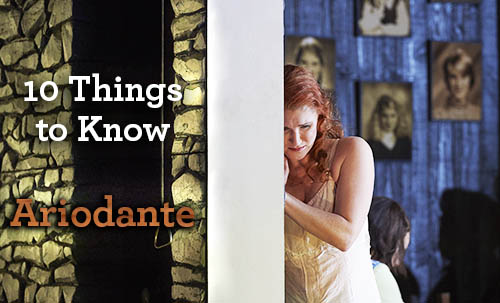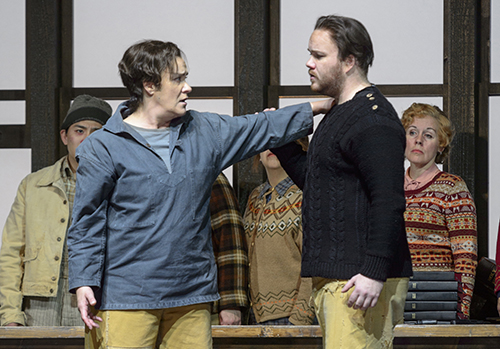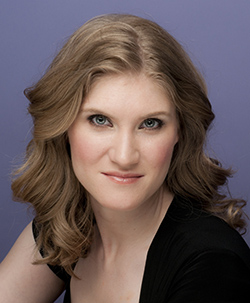-
10 Things to Know: Ariodante
By COC StaffPosted in AriodanteBy Nikita Gourski, Development Communications Officer

George Frideric Handel's Ariodante, the neglected musical masterpiece, has hit the stage at the Four Seasons Centre for the Performing Arts. Do you need a quick introduction or a refresher course on some key concepts and facts? Here are 10 Things to Know before you go!
1. ahead of its time
We do not tend to think of 18th-century composers as being especially adept at illustrating the inner workings of human psychology. Yet Handel was ahead of his time in this regard, consistently writing music that is precise in depicting characters’ psychological states, while offering credible arcs of emotional truth and character development. Indeed, the ongoing rediscovery and prominence of Handel’s works is attributable, at least in part, to contemporary artists’ realization of how truly modern and psychologically astute a composer he is.
2. A forgotten masterpiece and a COC First
Ariodante premiered in London on January 8, 1735. While initially successful, the opera fell into obscurity for almost 200 years. Since its revival in the 1970s it has come to be considered one of Handel’s finest works. This new production—created together with Festival d'Aix en Provence, Dutch National Opera, and Lyric Opera of Chicago—is also the COC premiere of Ariodante.
3. A Simple Plot
Prince Ariodante is poised to marry Ginevra, the daughter of the King of Scotland. But Polinesso—a charming yet odious figure that has ingratiated himself with the King—convinces Ariodante that Ginevra has been unfaithful. Polinesso manipulates the entire community into ruthless mob action against Ginevra, humiliating her and pushing her to the brink of insanity.
4. Brilliant, Luminous Music
Handel is one of the best-known composers of the Baroque era, a period in which contemporary dance forms heavily influenced the structure, composition, and the feeling of music (you’ll notice that the end of each Act in Ariodante is essentially an extended dance number, which this production uses to stage a play-within-a-play using puppetry). For a prime example of Handelian coloratura (a passage of singing when one vowel or word is stretched out over many notes), listen for Ginevra’s (soprano Jane Archibald in our production) lilting, “Volate, amori,” an aria describing the celebratory flight of two cupids. Not only does the singer “fly” through numerous notes on the word “volate” (fly), Handel’s orchestration musically reaffirms the image with oboes and violins that mimic the beating of wings with quick runs of 16th notes. Another highlight is “Scherza infida,” probably the most touching and lyrically beautiful aria in the entire opera—it’s sung by Ariodante (mezzo-soprano Alice Coote in our production) and follows the A-B-A form that is so characteristic of the Baroque period, in which the opening section (A) is returned to again after a middle section (B), but repeated with the addition of more and more elaborate vocal embellishment.

Above: Alice Coote as Ariodante and Owen McCausland as Lurcanio in the COC's 2016 production of Ariodante
5. The Theme of Judgment
Acclaimed English director Richard Jones (last with the COC for Tchaikovsky’s The Queen of Spades in 2002), sets Ariodante in the early 1970s, on one of the Scottish isles. The seaside community is a male-dominated one with a moral centre based in Calvinism. (The religiosity of the isle is established in the overture with a mime play of a sermon being delivered.) In this context, Jones and his creative team envision Ariodante as a story of intolerance and judgment, a story of a young woman who is punished by a male community for her sense of imagination.
6. A set design in mind
The set design by Olivier Award-winning British designer ULTZ is a cross-section of a building, with three distinct rooms including a kitchen, a main room, and Ginevra’s bedroom. The walls between these rooms are not physically present, but instead suggested by thick white lines painted on the floor and ceiling of the set. This has the effect of inviting the audience to take up an active role in the collective act of theatrical creation, with every person in the theatre becoming complicit in the imaginative integrity of the set’s architecture, and, by extension, the emotional truth of the opera itself.
7. Costumes reflect the community
The costume design—also by ULTZ—emphasizes that we’re observing an environment of labour, a community reliant on fishing and wool industries. As such there’s similar costuming for men and women: workclothes that privilege functionality and durability as opposed to ornament or self-expression. Ginevra, however, is distinct in this regard with her floral dresses and splash of colour marking her out from the rest of the community.
8. Nothing extraneous on the set
Each prop, costume, and element of set design in Ariodante has an irreplaceable role in the unfolding drama, including the knives hanging in the central room, the suitcase in the closet, Ginevra’s hairbrush, the Bibles arrayed in the back of the main room, the bottles of whisky hidden throughout, etc. Each object and gesture is thus imbued with a dramatic energy and potential storytelling weight.
9. A First for Johannes
COC Music Director Johannes Debus makes his Handel debut with Ariodante, saying in the lead up to the premiere: “This whole cosmos of Baroque music really fascinates me and Handel, in particular, stands out as the one with the greatest melodic inventions, maybe, ever."
10. A Dream Cast
Handel’s music requires extraordinarily agile and expressive singers, and the COC has gathered a world-class cast, including our very own Ensemble Studio graduates soprano Ambur Braid (Dalinda) and tenor Owen McCausland (Lurcanio), as well as current Ensemble Studio tenor Aaron Sheppard (Odoardo), with some of the world’s leading Baroque artists in lead roles:
 Ben Ealovega 10 things.jpg)
Mezzo-soprano Alice Coote
AriodanteRecently with the COC: Ariadne auf Naxos (2011) and Hercules (2014)
Her performances are described as “breathtaking in [their] sheer conviction and subtlety of perception” (The Times) and her voice as “beautiful, to be sure, but, more importantly, it thrills you to the marrow" (The Daily Telegraph).

Soprano Jane Archibald
Ginevra
Role DebutRecently with the COC: Don Giovanni (2015), Semele at the Brooklyn Academy of Music (2015), and The Marriage of Figaro (2016).
“Unbelievable mastery of singing, controlled with apparent ease… combined with a remarkable dramatic presence” (Le Figaro, FR).

Mezzo-soprano Varduhi Abrahamyan
PolinessoRenowned Armenian mezzo making her Canadian debut
The New York Times has called her a "revelation."
Ariodante is running from October 16 to November 4. For more information and tickets, please click here.
Photo credits (top - bottom): Jane Archibald as Ginevra in Ariodante (COC, 2016), photo: Michael Cooper; Alice Coote as Ariodante and Owen McCausland as Lurcanio in Ariodante (COC, 2016), photo: Chris Hutcheson
